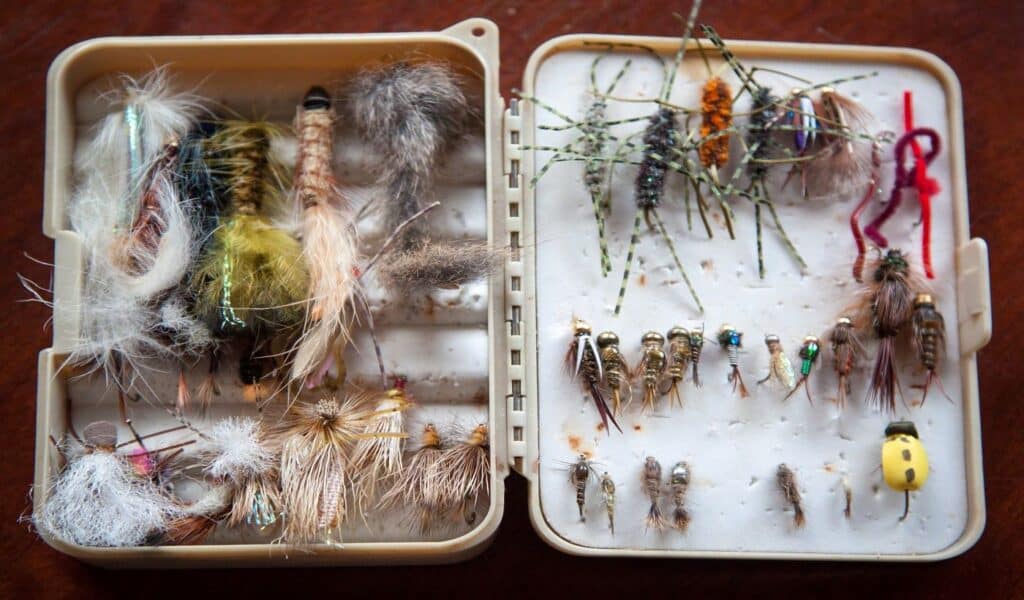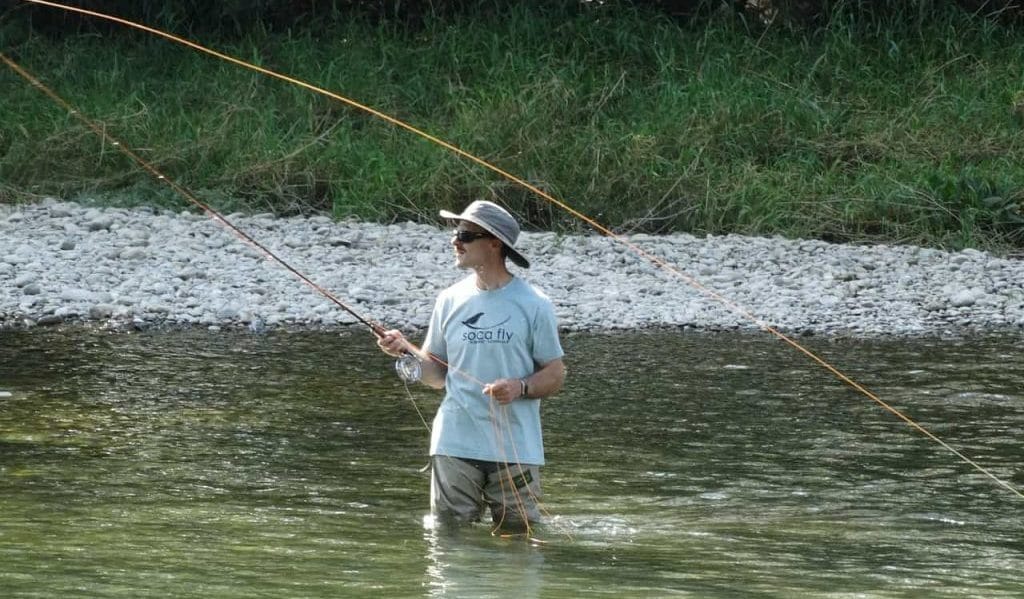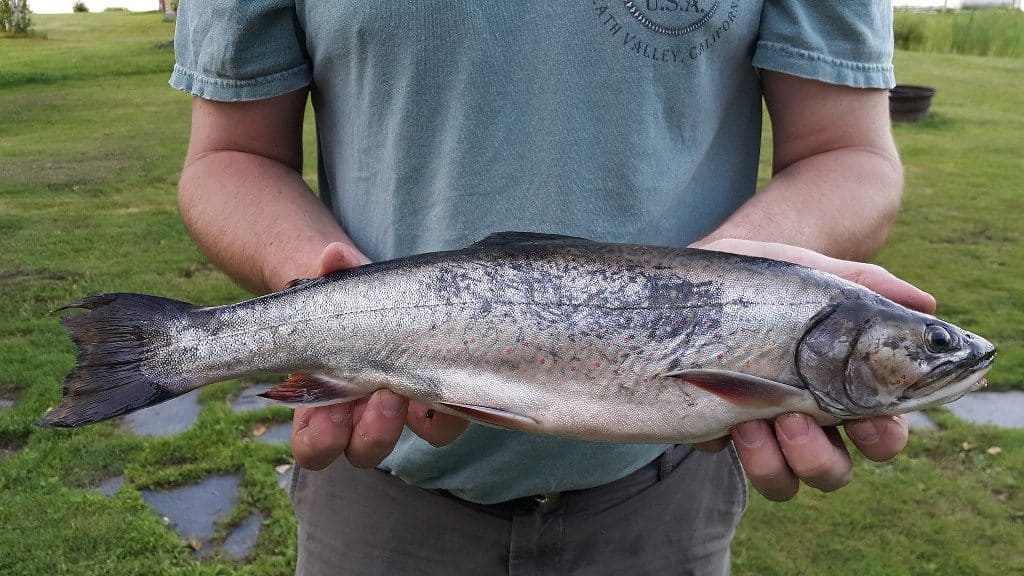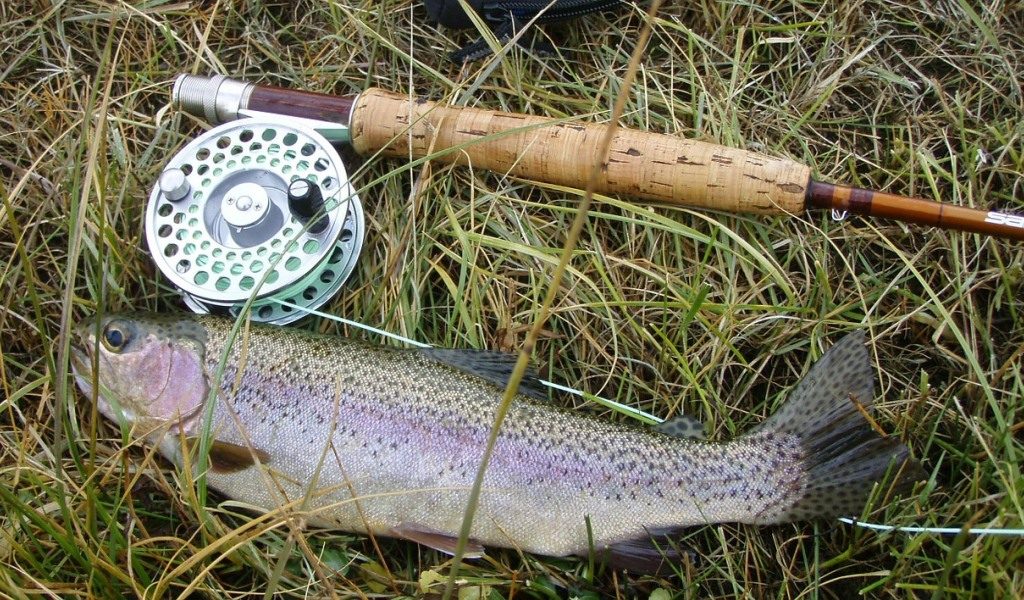Wet Flies vs Dry Flies: Your choice of fly depends on the fish you are targeting. All seasoned anglers know they’ll need both wet and dry flies for a successful fishing trip. Although everyone has their likes and dislikes.
Many anglers find dry flies exciting as they can see the fish biting on their fly. This makes the setting of the hook more exhilarating. But if the fish around you are biting underwater, there’s no use throwing dry flies. So it doesn’t take rocket science to understand which type of fly to put into action to catch fish.
What are Wet Flies?
Wet flies resemble insects that live underwater. These include the nymph stages of insects that move along with the water current. Fish aim for such underwater insects and we aim to catch fish using our wet flies.
Wet flies use bead heads, copper wires, or fly-tying materials to add enough weight to sink the flies.
What are Dry Flies?
Fish tend to feed on the grown-up insects that land or flow on the water’s surface. Dry fly fishing takes advantage of this instinct.
Dry flies float and stay on the water’s surface to resemble such insects. They are commonly used in freshwater, as insects seldom hatch in saltwater.
How to Decide Which?
Difference factors like current, time, season and the type of water dictate what the fish are feeding on. So, you can pick the right fly to use after observing the water.
If you see the trout feeding on the surface, you can notice what they are feeding on and imitate their food using a dry fly.
But if you don’t see any trout feeding on the surface, they are more likely feeding below. This is when you use a wet fly to lure them. Remember, more than 90% of what trout eat is below the surface.
If you can imitate the natural pattern, it will increase your chances of catching a fish. Even a small river has a vibrant ecosystem composed of specific organisms.
7 Key Differences Between Wet Flies vs Dry Flies
While fishing with dry flies is very exciting as you get to see the fish falling for your trap, wet fly fishing is exhilarating due to the number of fish you can catch.
But, unless you are aware of the differences between wet flies and dry flies, you may not be able to decide which one to use. So we have shared some of the key differences to help you decide whether to put wet flies or dry flies into action to get the best results.
1. Materials and Construction
The dry flies need to be lightweight enough to float on the water. So, most dry flies are made with feathers, foam, and hair to help them float better.
While dry flies that are tied with a hackle use stiffer materials, wet flies use softer materials.
Wet flies need some weight to sink into the water. This is why soft and shaggy materials are used in making wet flies. Such materials absorb water and help fly sink deeper. Nymph is a type of wet fly that also uses weights near the top of the hook to make them sink.
Shaggy materials also help create wriggly movements in the water to entice the fish. Many wet flies even use bright colors to attract fish. This is why wet flies are often more successful in getting the fish to bite.
2. Size and Weight

Dry flies are lightweight and float on the surface. Wet flies are heavier to allow them to sink below the surface.
Another key difference between wet and dry flies is their size.
Wet flies are generally larger than size 10 while dry flies are usually smaller than size 12. Bigger sizes are denoted by smaller numbers.
Streamers may be some of the biggest flies in your box. They could range in size from 8 to 1. You can use them to attract predator fish. Remember, the bigger the fly, the bigger the mouth of the fish that bites.
3. Ease of Use
You need acute observation, knowledge, and skills to use dry flies. You can get the fish to bite only if you’ve recognized the food and conditions right.
Also, you need to make very natural presentations with dry flies. Trout don’t bite if they suspect your fly is not food. It may spook the fish and the whole school may scatter.
But, it is relatively easier to fool the fish under the water than on the surface. So most beginners start with wet flies as they are easier to use than dry flies. It is the most important difference between a wet fly and a dry fly if you are new to fly fishing.
Wet flies also offer a higher chance of success as the wriggly movements of a streamer are hard to avoid for fish. If you are new to fly fishing, you can check out our Fly Fishing Tips for Beginners to help you get started.
4. Imitation
Imitation is another important difference between dry flies vs wet flies.
Wet flies are imitations of insects that usually live below the surface of the water. So, wet flies typically resemble creatures like leeches and crawfish that live below the surface of the water. Wet flies are often used to catch the attention of the fish using bright colors.
Dry flies are imitations of insects that commonly land or flow on the surface of the water. Grasshoppers, beetles, and cicadas are some of the most common dry fly patterns. But, it is very challenging to make dry flies appear realistic as fish can easily detect fake objects on the surface. So you must make natural presentations while using dry flies.
5. Casting Distance
Many fly fishers often try throwing long casts when they see fish rising at a distance. But, this may not be the best way to catch fish. It is advisable to keep your casts short so you can make quicker hook sets.
While using dry flies, you must avoid casting farther than fifteen feet. There are two reasons for this. A shorter distance will allow you to keep an eye on the movements of the fly.
It will also help you land the fish once it bites. A longer cast may seem exciting. But it will not help you land more fish.
If you are using nymphs, you can cast up to five to ten yards up the stream while keeping the tip of your fly rod high. This will help you imitate the natural introduction and descent of the nymph into the water.
6. Casting Technique
It is important you don’t become too eager while using dry flies. An imperfect cast can easily scare away the fish. So your casts must be perfect.
If you are a beginner fly angler, you can start throwing dry flies using a roll cast to avoid false castings. You can learn more ways to cast as you gain experience.
Casting techniques for wet flies differ with the type of fly.
A streamer will ensure more success if you throw it into a rapid turn entering a still water body. Casting into a rapid will increase the wriggly movement of the streamer and attract more fish.
The right way of casting nymphs is to let the fly naturally drift downstream. Hold your rod tip high so that there is no chance of your fly getting stuck.
Emerging flies are best cast similar to dry flies. The tips of the wings of the emerging fly must be visible on the top of the water.
We suggest beginners use a single fly rig with a single fly tied at the end of the line. Once you get more experience, you can try multiple fly rigs with two or three flies. The dry dropper rig uses two flies – a dry fly and a wet fly. The wet fly is tied at the end of the line while the dry fly is tied a few feet above it.
7. Best Time to Use
The best time to fish a dry fly is when hatching occurs on the surface of the water. There is no reason the trout will navigate to the surface when they can find adequate food underwater.
So, seasoned anglers using dry flies align themselves with the rising or the setting sun as this is when the hatches occur.

Streamers can be fished whenever and wherever. There is no particular time they are more rewarding. Fish prefer a streamer even when they are feeding on topwater hatches. They will attack streamers even when the day is too hot or the fish have gone deeper in the water.
Nymphs work best in the early morning hours. These flies appear like nymphs when they just start hatching. This is when your nymphs will be the most successful. Their heavy beaded heads will enable them to reach an adequate depth.
Fly anglers use emerger flies just before hatching starts on the top water surface. Emergers have underdeveloped wings so they cannot get on top of the water. If you see fishtails popping out of the water, know the fish are feeding on emerging flies.
Conclusion
The dry flies are lightweight and the construction material is usually hair or foam that can float on water. Wet flies are generally soft in construction and use water-absorbing materials to make them sink.
The casting techniques for dry flies and wet flies are also different. Beginners may find casting with dry flies a bit more challenging. But any experienced fly fisherman knows you need as much technique even if you fish wet flies. You must be ready for a heavy and aggressive strike after letting a streamer into the water.
You must set your hook as soon as you feel a tug on your fly line. You might even see the fly getting away in front of your eyes. There is little time for you to make the catch while using wet flies.
We hope you now understand the differences between wet flies vs dry flies. With focus and observation, you can pick when to put a dry or wet fly into action.
Last Updated on May 15, 2025 by Blaine Townsend




